January 31, 2004
PUBLIC, into the Soup you go!
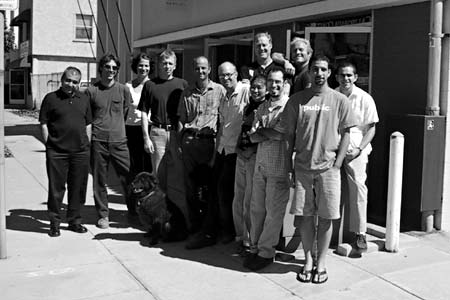
I've just found the website of my great and old friends, Jim Brown and Jim Gates, owners and architects of the firm called PUBLIC in San Diego. These guys, together with another school mate, Robin Brisebois are heirs to the legacy of Ted Smith and Others, a architectural firm like no other. Ted taught these guys how to build thier own projects and off my buddies went to amass a portfolio of great work. In another life, I would have liked to have apprenticed together with them to Ted. There's a lot more to describe about them and Ted too. Rizzoli should do a book about him for sure.
I'll write more later of course. For now, let this serve as an announcement that they are forthwith, in the Soup of Links!
January 30, 2004
Good Morning
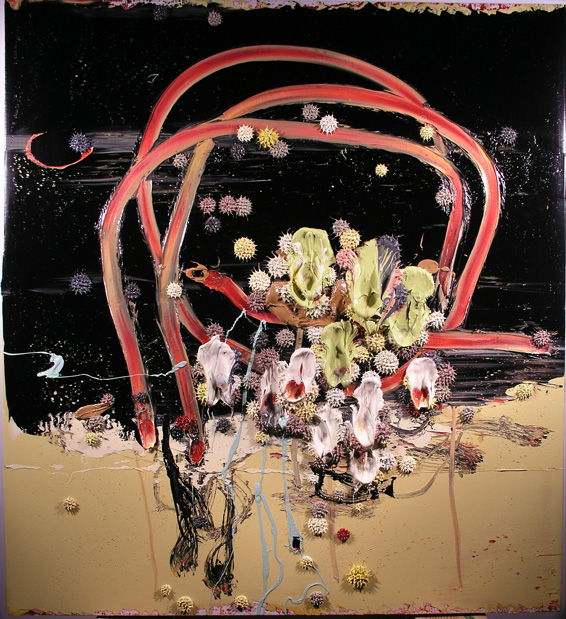
I finished this in the wee hours of the morning after a long tussle.
The trouble was, I was painting in a room with five other paintings hanging in it. And I kept looking to my left at this painting... too much.
This is the second time in as many paintings. In the last painting, I took the portrait schema and smeared figure into field from edge to edge. I couldn't... wouldn't do it agian.
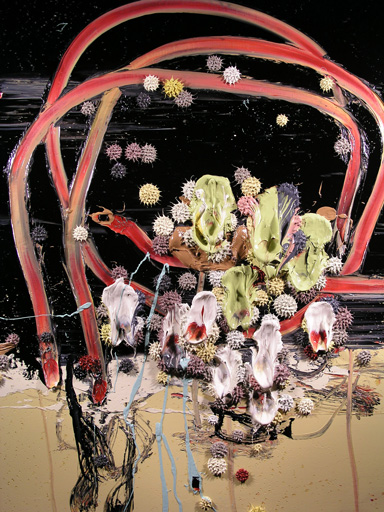
Unsatisfied with the direction it was going, I loaded a knife with Ivory Black and laid a smooth field of over everything that I didn't like about what was happening with it.
An edit, again.
My modus operandi.
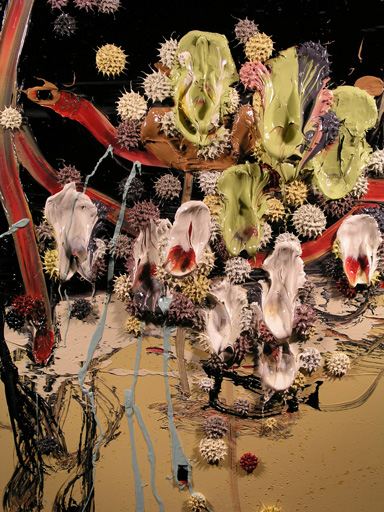
Which gave me a horizon line. Another picture.
And since I was drawing again, I thought that I might as well draw s'more.
So I stepped up with a fist sized pillow-pad and scribed two squarish lines circularly, canting the angles for attitude. As I stepped back, I remembered a work on paper I did a while back. I was tracking on the same turf as before.
Funny how that works.
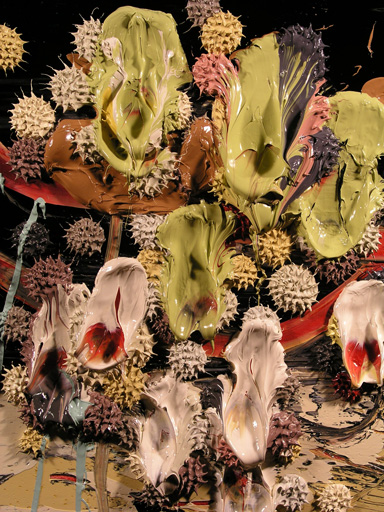
There I was, in the place when I was looking at the early Mondriaans at the Dallas Museum of art. Drawing and painting.
So I relaxed and kept going. I looked for a congestion of paint in the face of the painting. I remember the Rembrant era thing of alla prima highlights at the end of a painting. First, a monadology, a clustering of spiny forms, everything an edit, every act looks for it's reason in parts of the painting that I don't like.
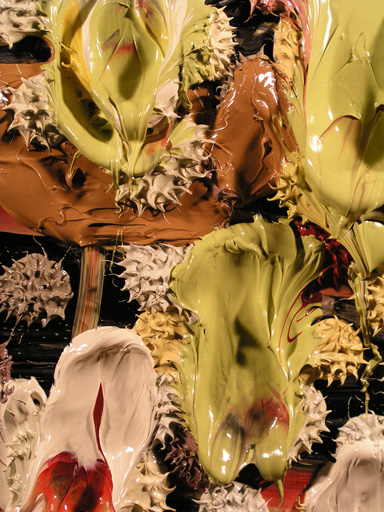
And what don't I like? The scruffy messes. The goofs. You can just tell, or at least I can. I can see them immediately, they stand out. And I want to stamp them out.
Or cut them out.
Or cover them.
Until it's done.
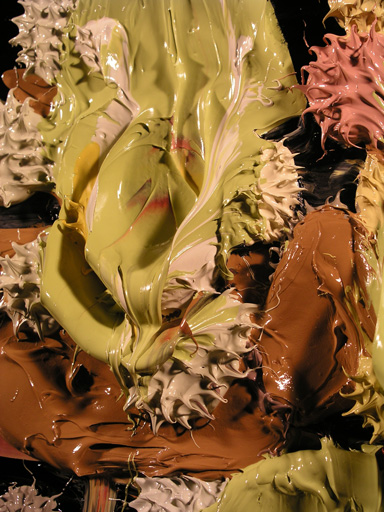
January 29, 2004
Newsweek's Spain
Check this out from Newsweek, via John Chappel's Iberian Notes:
The picture is similarly rosy in Spain's second city, Barcelona, one of Europe's most stylish?and most fun?metropolises (following story). With the economy booming?in stark contrast to the rest of Europe?it's no wonder Spaniards these days are the most optimistic consumers on the Continent, according to surveys. Columnist Raul del Pozo of the newspaper El Mundo argues that Spain's new golden age is an epic achievement?the greatest European economic leap forward since postwar France and Germany.
Drawing and Painting
Still thinking about drawing and painting.
Here, a passage harvested from an online text on the ancient Greek painters:
The most important technical advance, however, is attributed to Apollodorus of Athens, a painter of easel pictures. He departed from the old method of coloring in flat tints and introduced the practice of grading colors according to the play of light and shade. How successfully he managed this innovation we have no means of knowing; probably very imperfectly. But the step was of the utmost significance. It meant the abandonment of mere colored drawing and the creation of the genuine art of painting.
So, color gradiation and light and shade are the qualifications? I don't think so.
I was googling for the account of the painter in ancient Greece who after trying to paint clouds to no avail, trew his rags at the (canvas?) and presto! I think I've just arrived at that exasperated moment of resignation/deliverance tonight too.
I haven't found it, but here's a better link to the general subject than the one above.
January 28, 2004
Saltz on Gorky via Rosenberg
I wish I was in New York to see this show (in the snow, too!):
"Arshile Gorky: A Retrospective of Drawings," Nov. 20, 2003-Feb. 15, 2004, at the Whitney Museum of American Art, 945 Madison Avenue, New York, N.Y. 10021
Check this out... Jerry Saltz, who's reviewing the show, an article I found in ArtNet:
Describing Arshile Gorky's painstaking apprenticeship from afar to Picasso, Harold Rosenberg wrote, "From Picasso Gorky learned: above all, keep at it. If you have no ideas, draw the model. If you have no model, copy reproductions. If you are depressed, draw; if you get drunk, go home and start a picture. If there is shooting outside the window, go on drawing. For the artist, there is only one real situation, and only one salvation: art."
January 27, 2004
Still Scraping
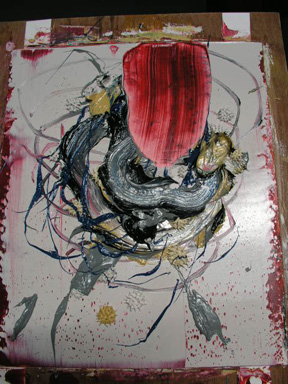
This one was scraped off.
As Gephart referred to Bush, it was a "MISERABLE FAILURE"!
I'm poking around for a way into the next two paintings, both 48"x44". I'm working on paper to figure it out. The trouble with this is that the paper surface is smooth and the linen surface is like sandpaper. 220 grit.
So whatever I do in paper is a distraction from the bigger panels.
(grunt)
What I am doing on paper is thinking about drawing and painting. I went to the Dallas Museum of Art this afternoon with Stephanie to look at their Mondriaans (that's how he signed his early paintings), and Dubuffets among others. All I saw was drawing over painting, and painting over drawing. It's nice to walk to the museum when you need a shot in the eye once in a while.
The work on paper (wop for short) above was errant in a goofy sloppiness. Every mark made was spinning out of the frame. Here's its' successor in progress:
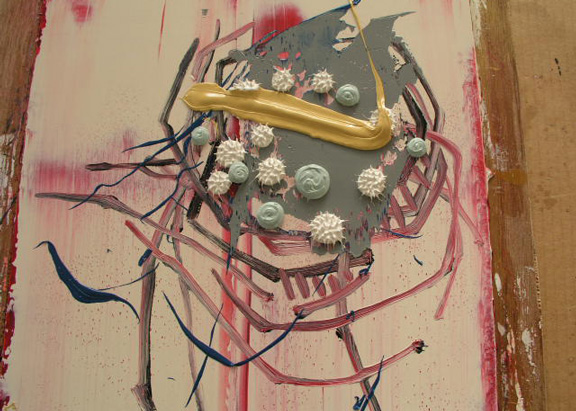
I like to think that these paintings are all about a high level of control per square inch/centimeter. I look at the whole surface, looking for intention and editing out or over any lack of intention. Here's something I've come across in the book I'm reading (Albus quoting Panofsky):
Jan van Eyck evolved a technique so ineffably minute that the number of details comprised by the total form approaches infinity. This technique achieves homogeneity in all visible forms as calculus achieves continuity in all numerical quantities. That which is tiny in terms of measurable magnitude yet is large as a product of the infinitesimally small; that which is sizable in terms of measurable magnitude yet is small as a fraction of the infinitely large."
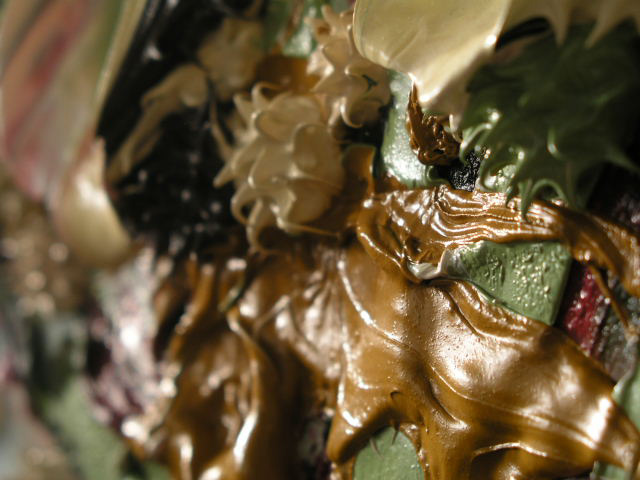
Meanwhle, the large panels await.
And I fret.
That's how I do it.
January 25, 2004
Parallel Cities Reflux
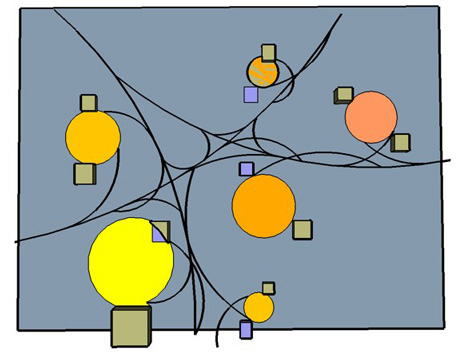
Shades of Parallel Cities!
Years ago... eons ago, I came to the thought that a vision for architecture had to be predicated by a vision of the city. I was riveted on two indices of scale that frames the disposition of the city. One looked towards human scale and therefore into a history where nacent technology had not yet superceded the extents of human limits to order the city. The other sees cities morphing into a superscale fit to the superhuman lives of the new inhabitant (that's us by the way, you and me... our lives), inhabitants who eagerly strap on new technological prothesis to transcend human limits. Cars extend the legs, telephones extend the voice and ears, internet extends the mind, television and movies extends dreams. As the Pioneer probe speeds into interstellar space, there seems to be no wall for this phenomenon.
I was just out of architecture school when I came to this conclusion. Thinking of my previous post that was devoted to my architectural mentor, Gil Sanchez; I remember a moment driving to work at the time I had begun working for Gil, thinking that I could not merely practice architecture*1 for the sake of good taste alone, archtiectural design had to have an orientation. The knight needed a King/Queen to fight for. (Funny to think that now, I can consider an argument for the artist as mercenary... or the opposite, the Roshoman. But nihilism is the certified problem of our time, not a good foundation to build on.)
I have to stop myself from running a ling expostition on Parallel Cities, but click on this link if you need a little more background. Onto the links:
Check out this article about how scale is changing the art world:
"All of these very different works have one thing in common: size. For centuries, sculpture has retained an inheritance from the Renaissance so fundamental that it went almost unnoticed ? its scale. A Giacometti or a Henry Moore may look rather different from a Donatello, but they have in common their human dimensions. They are works that fit snugly into a less than colossal room or the confines of civilised square. One interesting exception to this rule is Michelangelo's giant David ? the greatest sculptural star of all ? but even he would dwindle in the mighty Turbine Hall."
(Also, read his very interesting proposal at the tail of the article, echos of SuperStudio, the Italian architecture collaborative who imagined fanciful superscaled cities.)
And now this from Edward Rothstien in the NYTimes, who focuses first on the phenomena of the WTC designs and how they focused on the private over public memorial. He then he extends this into the way we think of cities nowadays:
But now this kind of debate is typical of urban life. The city is a terrain wrestled over by competing private interests. The city's greatest achievement, it often seems, is the protection of the private realm and competing private interests; about the public realm there is no clear understanding.
After recounting Jane Jacobs he introduces a professor of political science at Yale, Douglas Rae, who pronounces the end of human scale in the way we knew it from the past:
Mr. Rae finds the very qualities of urbanism so often celebrated: close-knit neighborhoods of mixed populations and businesses, flourishing factories, communal and religious organizations, all of which helped create a sense of public affiliation. But that urbanism, he stresses, should not be idealized; it was accompanied poverty and filth and social ills and was the result of forces that cannot be replicated.
During the second half of the 19th century, Mr. Rae points out, there were "accidents of urban creation," forces that favored high-density, centralized growth in particular locations: the rise of steam-driven manufacturing, the development of a rail system and a national marketplace, sustained waves of immigration. But then came the disruptive centrifugal forces created by the introduction of the automobile and the AC electric grid, which ultimately helped bring urbanism to its end.Here's an article by Ann Wilson Lloyd (again, the NYTimes) that's related to Car City in that the "Bilbao Effect" they refer to is simply a super suburbanism: building as object in a field versus one that is part of an urban fabric:
ust three days into a new exhibition this past September, the Bellevue Art Museum in Bellevue, Wash., abruptly closed its doors and suspended programming. Among the reasons, according to an article in The Seattle Times, were regional financial woes, an unclear mission and leadership conflicts. But another, less familiar issue was also raised: the museum's building, a three-year-old avant-garde edifice designed by the New York architect Stephen Holl. As the article explained, public support for the new museum was weakened by "galleries poorly suited to traditional art shows."While the institution's past and present leaders are still assessing the situation, many ? including two former directors and the current board chairman ? acknowledge that the new building, with its expansive, soaring interior, called for programming that left local audiences disenchanted.
Bellevue may be the first casualty of a phenomenon known as the Bilbao effect: following the example set by Frank Gehry's Guggenheim Museum in Bilbao, Spain, museums are commissioning high-style architecture that will not only raise the profile of the institution but boost the economy of the area. But in addition to spectacular architecture, this can also produce exhibition spaces less in service to works of art than in service to the building itself as art.
There was another article that treads the same territory. It had too much to excerpt and at the same time, too little that blazed different enough territory for me to blockquote here. But it's worth checking out. All of this came form surfing ArtsJournal.com, a hat tip to them.
Back to the studio, Dennis.
*1Yes, for those of you who might be surprised, I was open to the possibility of an architectural practice at one time. At one time, I wanted to do what I thought Corbusier did: painting and architecture and sculpture, all three in the grand tradition. But the cookie didn't crumble that way: I realized that I couldn't paint at the level I wanted to if I divided my time/mind into thirds. And making art in a fusion of the three was a hoary cliche by those times of high theory in the art world of the end of the 80's.
I found myself having to make a choice of one or the other (that is, architecture vs painting, or perhaps one then the othe. Besides, Corbu wasn't a particularly accomplished painter. And painting was the mother of my arts and I still find it to be demmanding.
January 23, 2004
Currently Reading...

Today, I bought a book at Half Price Books here in Dallas (a fabulous book store): "The Art of Arts, Rediscovering Painting" byAnita Albus. With our looming move, I'm trying to sell books, and not buy them. We are trimming down our book collection for travel, keeping only the essentials. So, even though I was initially attracted to this slim paperback, I had to be won over by:
1. the subject (I quote Amazon's description: "But this miniaturist's view of the northern Renaissance will copiously reward those who peruse it slowly, especially artists. ");
2.the passages that show plunges into paintings such as those by Jan van Eyck and many others...and other passages that are flights into subjects that remind me of what I like about Melville;
3. paragraph long sentences and short stubby chapters;
4.an appendix called "The Lost Colors", which reminds me of Philip Ball's "Bright Earth", where both reveal the hidden physical and chemical structure of pigment;
and the coup de grace:
5.the first glossary entry: "alla prima".
Gotta have it.
I hope it's good.
Hi Gil!, Hi Daryl!
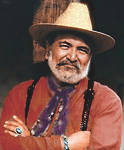
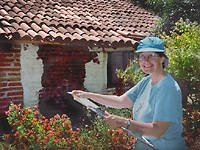
Today, I finally called Gil and Daryl to give them our coordinates after a little hiatus when we departed Callifornia to move eastward. Gilbert A. Sanchez, F.A.I.A. is my friend and architectural mentor. I was lucky to meet him when I was a kid, a student in an architecture school in the South Bay area, the early days straight out of the Navy. He was a guest lecturer at a materials and methods class. When I saw his passion for the substance and spirit of architecture, I had to meet him. It was my honor to work for him as an apprentice and Gil taught me a great deal, laying the very keel of what it means to be an architect within me.
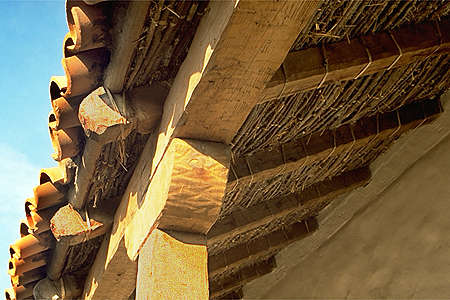
In his office, I was able to work on the drawings for Mission San Jose in Fremont, the Santa Barbara Presidio, and on one occassion, I was able to replaster the Peralta Adobe with his father (who was in his seventies at the time, and he kicked my twentysomething ass, outworking me all day long). My experience with him is indelible and I wouldn't have any other way.

Gil met Daryl in these early days I've just described here and they are a perfect team together. They form a wonderfully loving (and professional) husband/wife architect team, work and home for them is seamless. Stephanie and I can't wait for them to come visit us in Tossa!
(Gil, your website is going into the Soup of Links too.)
January 22, 2004
Train of Events
We've been schedulin'.
Finish Paintings for Armory Show
February
Stephanie goes to SACTO
(she does 2 shows)
Dennis goes to SACTO
Dennis returns to Dallas
Crate and ship to NY
Crate and ship to Tokyo
March
Stephanie returns to Dallas
Dennis goes to Houston
(lecture at University of Houston)
(hang time with Aaron+Sharon)
Dennis returns to Dallas
Sort, Box, Sell and Ship
Pack up the U-Haul
We drive to Los Angeles
Unpack truck
Hang time with family and friends
April
Leave for Barcelona
Easter
(relax...sort of. fix house, learn spanish, set up studio and work toward the Z?rich and Cologne shows...)
Loft for Lease
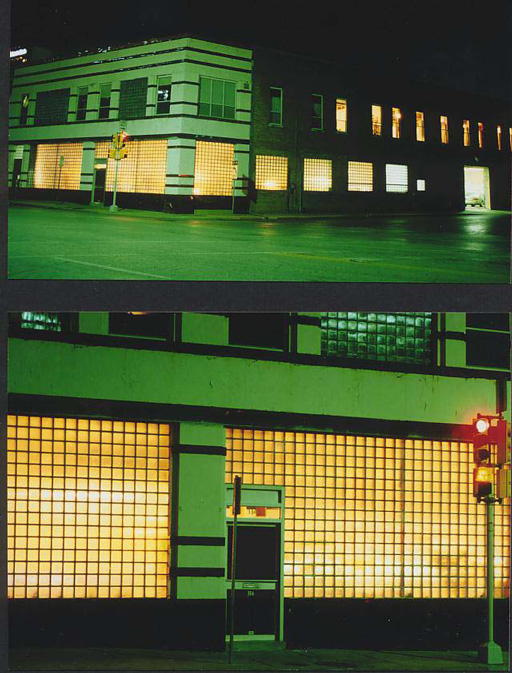
Pamela Nelson and her husband Bill have been great landlords and we count ourselves fortunate to have become friends as a result of our adventure in Texas. The image of the studio above is taken from her website, which I shall put into the Soup of Links to the left. She's an artist who came out of the art school at Southern Methodist University. As you might see from her work in her site, and as I have seen in meeting her compatriots here in Dallas, she (and they, I here assert with hat in hand) have been influenced by their time in grad school when James Surls taught for a spell.
I can see a Texan and Southern grain that comes from a touchstone of outsider-folk-eccentric artists and channeled into the likes of Surls, David Bates and Julien Schnabel. It all makes sense when you can trace the fecund line to New York.
January 21, 2004
Blobolicious
Ray is an old acquaintance, once a former architecture student of mine at Woodbury University in Burbank, he went on to grad school at the famous SCIARC, in Los Angeles; now that he's all grown up and we've worn off the generational boundary, a friend. He writes recently to fill me in the haps in architecture:
On Jan 21, 2004, at 6:47 PM, raymond wrote:Hi Dennis,
How are things? I've been checking out your web site as you have noticed. I like it but it only reminds me how much I miss visiting you in your studio but the virtural you is kind of cool. Check out this architect and tell me what you think. He teaches at sci-arc and is one of the hippest Digital guys at school. Thanks for responding to my comments on your web page and I hope to hear from you soon.
Ray
Ray:
I appreciate the link to the supercool hippest architect at SciArc. A blob for everyone, it seems. It makes me want to spend money on computer soft/hardware.
It also makes me want to rent that movie: "The Blob". Remember that one? Steve McQueen. He's one of the few actors who could be cool even in a B-movie like that one.
How does the humanities component of your thinking intersect with this?
Also, this aesthetic prompts thoughts about construction technology and the office, there must be bridges between the contractor's hammer and the software in the architect's office. Kinda like Gehry's Catia program and the automated fabrication of steel. This is where we will be able to build these blobs.
I google:
"It was computers that transformed Gehry's architecture. Using a complex program called Catia, made by the French company Dassault for designing aircraft, Gehry was able to achieve the results he sought. Computers mean that, however complex, the curves in his buildings can be accurately calculated and then fed directly to the cutting machines in steel foundries."
More than the bloboliciousness, there is a capacity of fit as we increasingly shape the environment to our needs, as the technology filters down to the public at large. Blobs are the least aspect of this phenomenon, or at least a metaphor for fit.
I can see something of this kind of software evolved over time and merged with gaming programs to simulate the environment so that we can customize, to fit the design to the micro particularities of life. Once we have the ability to field fabricate the components derived from the software design and simulation testing, then we could assemble them into a radicalized "form follows function", a do "more with less" environment. Here, I'm thinking of nanobots and scaling up from microfactories, and radicalized versions of desktop printers that can build houses that we imagine first in some hyperreal (will we call them computers then?)simulation.
Dreamy, huh?
-Dennis
ps: I think I'll post this in the blog...
January 20, 2004
Panama Canal Zone
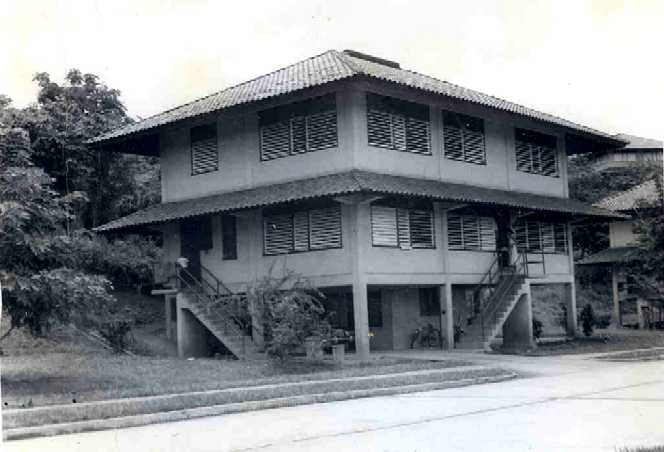
I found this image of my childhood home online recently. An example of base housing, Howard Air Force Base, Panama Canal Zone. I thought I would share it with ya'll.
Essentially, it's a duplex. First floor: carport and utility room, second floor: kitchen and living room, third floor: bedrooms and bathroom. Our place wasn't up against the jungle like this one.
I was there from the second to the sixth grade. Tropical. Johnson grass that can cut you. Alligators in Gatun Lake. Big fish at the farmer's market in downtown Panama city. Iguanas. Toucan birds that screeched and shit everywhere. A mango tree in the front yard with so much ripe friut that they fall and rot on the ground, too fecund for our ability to eat them. Sharks kept at bay with giant shark net barriers at Kobbe beach. Clouds of DDT dropped by aircraft roaring overhead. The big bridge. Lots of parties. Empanadas, mu delicioso. Kick ball. Lots of kids and bikes.
Mat, Too. In the Soup You Go.
...and while I'm at it, Mat Gleason's blog and the Coagula links within. I check it all the time.
Mat's a great guy, and now a legend in Los Angeles' art scene.
He did a good deed years ago, putting my face on the cover of his magazine.
Thanks, Mat.
Chris in the Soup
Tomorrow morning, I'll be visiting the new studio of Chris Jagers. He sent me the address of his website, and I'll toast the lad with an inclusion of it in the "Soup of Links" to your left.
Big Day
Today, we have purchased our plane tickets to Spain.
We depart CONUS on April 4th, 2004.
The calendar is getting complicated.
January 19, 2004
Nameless as Yet
Most of today was consumed with the task of shopping for a second laptop computer for Stephanie (and the house), sorting which Apple to buy. She will need her own machine with which to conduct her business.
Most of last week was a torque to a climax of painting, which occurred during the weekend. I let it lay on sawhorses so the paint can jell and solidify a little more before I hang it up.
Aqui esta, standing it up briefly for a photo:
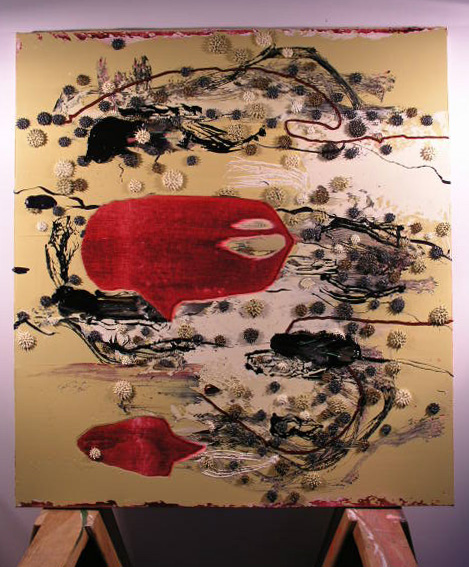
I worked first thinking of an image that caught-my-eye, the Bertolucci movie poster-posted earlier. I jettisoned the thought as you can see (or won't see). For those who might be taken aback at a movie poster as a touchstone, let it be known that I think you have to pay attention to the things in the world that catch your eye, no matter where it comes from high or low. Also, movie posters have this peculiar pictorial logic, in this case, I'm referring to the orchestration of color and mass: pinks and yellows and flesh colors with a punctuation of black that moves the eye around in circles like the blobs of a lava lamp.
Funny. I remember that when I was a kid, I rejected movie posters as a subject for emulation because of the formulatic qualities of them, and a feckless way image piled onto image like an ice cream sundae. Here however, I'm attracted to how image as color masses stack and arrange... the sundae became a lava lamp in that particular poster, an apparent motion detoxified the pop venacular for me forty years later.
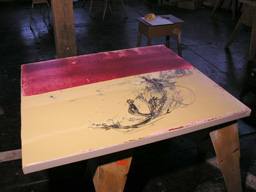
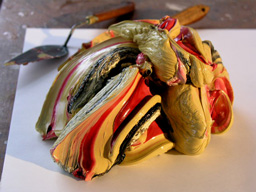
What I did navigate by- was a painting in ochre that I painted earlier last month. It was from a series that hung on the armature of the (self) portrait. Most times, it seems that I work this way: finding a motif as motive, a way to begin, a launch into the work, a track on a bead of inspiration that initiates a trek, (go ahead, write it Dennis, but write it with a referential self depreciating irony a la the line from the "Blues Brothers" movie...) a mission from G-d.
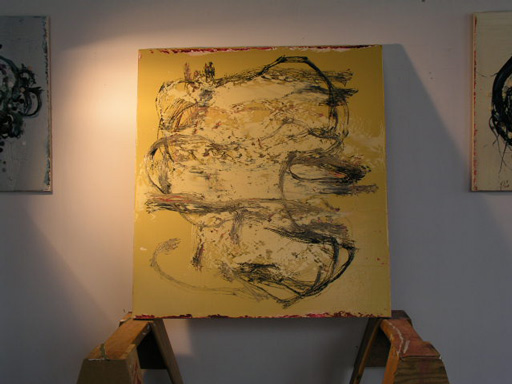
Back to the point: whilst I may take an inspiration to its conclusion, most of the time it remains a site of navigation, or something to use to gain acceleration from, like a gravitational sling that interplanetary spacecraft use. It gets me going into the thick of painting. Indeed, I am looking for the breakout, for the aspects of the painting that takes it to another place altogether. Sometimes I force it, subjecting the initiating inspiration to alternate ordinates. In the case of this painting, I was morphing the schema of portrait towards a schema of landscape.
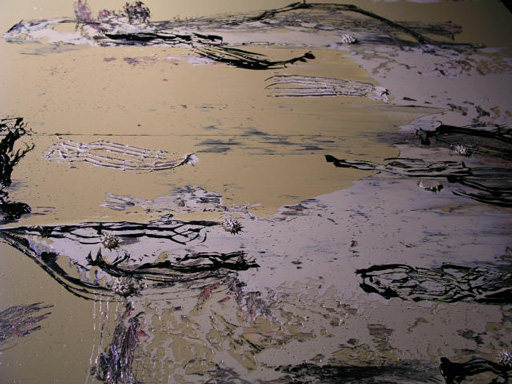
All of this is to describe the beginning of painting a painting (for me). There is a second phase, after I begin to sling away from the gravitational pull of the first inspiration, there is a misting or thickening. In the work of the past year, I've been looking for a density of paint, a crush of pigmented mass. Since I work with a surplus articulation of painterly marks, this takes time. And since I'm painting alla prima (whilst its wet, a hat tip to the Impressionists), time is something you struggle against. So, the second phase described here is a fervent accululation of articulated density. This density is a preparation for the third and final phase: big slammin' asteroid hits, the rocking, pounding, stomping flower blooms of paint that have been a significant feature for a year now.
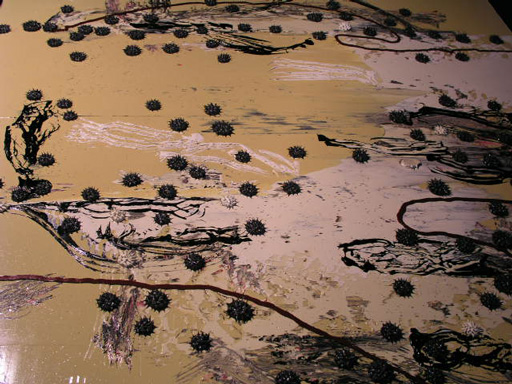
But...but...
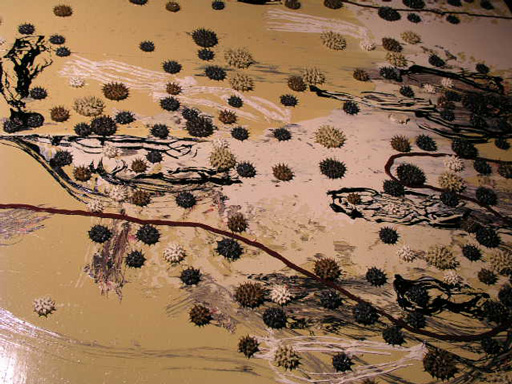
Whilst this was a favored approach, this particular painting didin't unfold this way. I was looking for fields of brushed red and pounded flower blooms of black to punctuate it here and there... but thirty hours into it, I saw that there was the beginning of a skin forming on the surface. As the paint dries, the surface evaporates volitile petrochemicals and the linseed oil begins to congeal. The surface begins to form a soft skin, like a hot chocolate drink does as it cools. I could have worked into it, but the inevitable granulation paint into tiny chunks bugs the hell out of me.
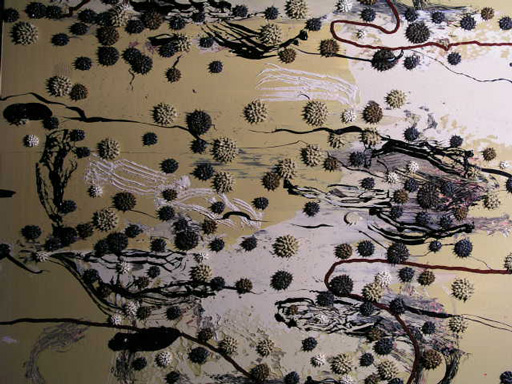
Crisis time. Thirty hours and the window was closing. The probabliity of scrape down loomed large because I wasn't going to get to the stomping grounds I had planned to do. But I liked what was there. I liked it and I had to find the other painting, part of which I was seeing and appreciating already.
I wanted to cut a couple of large holes into it, to let it breathe. Maybe by this, I can get the rest of what I liked in it to be seen by others too. I scoop the surface with a stiff piece of cardboard in which I cut into a suitable shape for the job. Big scoops are risky. I can anticipate the general properties of shape, buti won't know the character of it- weak or strong- until it's done.
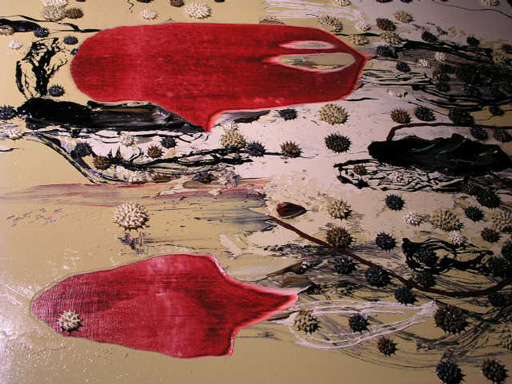
And it's done.
And I liked it.
And I like it.
Den Beste's "SuperHuman Intelligence"
First thing this morning, I got engrossed in Steven Den Beste's bogpost entitled "Superhuman intelligence".
He starts with serial versus parallel computer processing, then onto the human brain , and then this section about visual processing in the brain:
The vision center has been studied pretty intensively, however, and is moderately well understood now. In humans it occupies a section of the brain in the rear which is perhaps six centimeters wide and maybe 12 centimeters tall, and its job is to take a huge stream of data from the eyes and to process it to remove redundant information, to compensate for distortion (such as due to effects of lighting), to try to identify which sections of the field of view represent "objects", to evaluate differences in the images captured by both eyes and to calculate depth information from that, and in the end to create an abstracted symbolic representation of what is being looked at to send elsewhere in the brain for further processing at a higher level. The division of labor between the vision center and more general computing elsewhere is not known, nor how that abstract description is encoded, nor how we remember objects we've seen and can recognize them when we see them again, or identify the function of objects we've never seen before (like knowing that something is a chair the first time we see it).
At least in the early stages, visual processing is highly pipelined, probably with several parallel pipelines, and with groups of neurons at each stage of the process using the output of previous stages to create greater and greater degrees of abstraction about the image. So, for instance, in an early stage of the process in one pipeline there are neurons which are wired to look at a small number of pixels (i.e. the outputs of a small number of specialized light-detection nerves in the retina) all of which are physically very near one another, and to decide if there is a transition in brightness or color or texture between them. In a later stage, there are nerves which look at the output of transition-detectors which are evaluating contiguous regions, so as to try to determine if there is an "edge", and if so to determine its orientation and curvature.
By its nature, the most important aspect of all this is the details of interconnections between the neurons. If a transition-detector cell isn't actually watching contiguous pixels, then it won't be possible for it to make any deduction that is useful. But physical structure at that level of detail cannot be specified using the kind of encoding which DNA uses in the human genome. The gross structure of the brain is controlled, but wiring at the level of exactly which neurons hook to which other ones can't be.
Nonetheless, it works, because it is "self organizing". In the visual cortex of a newborn baby, the neurons are actually far more cross-connected than in adults. And in the first few months of life, one of the things a baby has to do is to literally learn how to see. Individual neurons begin to learn which of their inputs are actually important and which are not, and to pay attention to the important ones and ignore the unimportant ones. (Whether the unimportant connections are physically eliminated or remain connected but are ignored is not known. It may be a combination of both.)
It got my attentioin because he's writing about how we see with our brains and in this excerpt, he ends with the idea of "self organization"... a topic which has a political dimension which is extremely timely.
Later, he writes about hive minds and the internet:
But hierarchization can be used in internet-based hive minds just as it is in existing organizations, and most members of such hive-minds won't need to communicate directly with one another.
We know this can happen, because it's already happening. "Open Source Software" is one example and result of formation of that kind of hive-mind. Political blogging is another.
When it comes to blogs, power-law distribution tends to spontaneously induce creation of hierarchical organization, with contributors to high-traffic sites becoming de-facto leaders.
At any given instant, there will be a myriad of such hive-minds exhibiting a broad range of behaviors and capabilities. New ones would form all the time and old ones would falter and die. Some will only "think" in very restricted realms, while others may range broadly. In terms of observable intelligence level they would fall on a continuum. Some might be "geniuses", some "morons", some might operate at the level of animals or even plants. There will be the equivalent of diseases (i.e. chain letters). There will be the equivalent of parasites (file sharing networks pirating music and movies). Some will be valuable and constructive, some will be trivial and useless, and some will be insane. Some of those will be dangerously insane.
Sometimes hive-minds will form in response to others in order to oppose them. Hive-minds will compete and contend. Some will cooperate, forming coalitions. Sometimes that will cause them to merge. Some hive-minds will break into pieces, yielding children whose contributing members sort themselves based on their disagreements. And generally they'll be self-organizing, and many will be able to adapt to changing circumstances.
Memes are the thoughts of hive minds.
January 18, 2004
Bleary
It's close to midnight, and I've just finished the painting.
After a strange delayed start, I was laying paint down by Friday (went to an art opening and a party) and scraped it off Saturday morning. Now, thirty six hours later, it's done. I don't know if i'll like it in the morning. After a shower, I walked back into the studio to see if I would still like it.
And I do.
I'm not coherent enough to write about it now. More to come in the morning.
Suffice it to say that this one was finished with a coup de main, a cut or scoop that excised a sizeable chunk of paint in the center. Ventilation. Big time.
January 15, 2004
Deep Water
Another sounding of the depth of the malaise within architecture:
"The proposals to date have been on the unambitious side," Ms. Helfand said. "They are not on the level they should be. This is an opportunity for new ideas. After all, excellence is what the Olympics are all about."Ms. Helfand said she hoped that the best ? architecturally speaking ? was yet to come with the design of the Olympic Village, where the 16,000 athletes would live three or four to an apartment for 17 days. An innovative design study is under way to select an architect for the site in Queens West, across the East River from the United Nations.
The Olympic Village selection process attracted 132 architects, both unknown and renowned, from the United States and abroad, who submitted their qualifications in November.
Awww you guys!
Aw man! I can't believe I just did this! I've just lost this fabulous post. With one errant click, it slipped back into the the depths of the hard drive, lost forever.
It was deep. It was nuanced. It was longish. It was footnoted, hypertexted, and blockquoted up the yin yang. It was goooooood. It was about painting and imaging, and abstraction. I touched on Frances Colpitt and Kandisnsky and the Jewish Museum of New York, and the monochrome people and beauty and the human need to see things in other things. It was very goooooood.
Now, it's gone.
January 14, 2004
Writhing
Blogs beg a daily diaristic treatment, so with every passing day, I become more conscious of the need to keep you guys posted. While this is indeed a diary of the studio, I try not to go "full monte" on you.
You can thank me later.

What has been happening is my usual run up to the next brace of paintings. For some reason, I am not the type to walk up to art materials and bust the move from a cold start. If, like now, there has been a hiatus, I seem to need a little head time*1 before I begin to move materials around with conviction. I remember the Picasso movie where he paints on glass for the camera. Those paintings sucked. (Still love Picasso, tho!)
If there was a live studio cam (a la Jenni-Cam), what you would see is a guy staring at the walls, and if you could install a camera inside my head fro a mind's eye view, you would see the image of Captain Willard I conjured in an earlier post: " Broken glass, slobbering, butt naked, tear stained self indulgence, flat on my ass..." and like I said then: no worries. This is all too familiar for me, a necessary start up phase.
What is "Captain Willard" thinking?
What is painting? What have I done so far? Where am I going? What are those tendrils that connect the materiality of paint with the conceptuality of figuration? Am I right to foreground material over image*2? If figuration powers the abstract project, as I have thought and stated in the past, how have I unhinged it before, and is there another way to rearrange it? If there is a figure beneath the material that I'm striving to make vivid and palpable, can I just paint a Rembrant-like self portrait? Aw, jeez... my skin crawls at the thought of the simplistic flicks of the brush that articulates a crude schema of eye, nose, mouth, chin, hair, ears...
I pull out a few of my books: Auerbach, Soutine, Bacon, Hodgkin... all imagists in different ways. If I am the mirror of Peter Saul, I am a mirror of these painters too. But a mirror is a reflection in reverse. I can only reflect them only if I reverse them too.
I've been thinking of the black paintings, the dark Monets. Is this the time to take this on? In my mind's eye, I see floating pools of color reds, yellows inflections of blue, purple and green... and over it all is a sheet of black that skips and tears over, intensifying the color. I've been thinking of light yellow and white works, with rose like flower like eruptions that float like lily pads.
I've seen a movie poster of figures and I imagine a painting with colors floating down the surface, slabs of color: flesh, pinks, baracketed by blacks and umbers, detail concentrations where the faces are, drawing the eye down a painting to float back up in clouds of pink. I don't know. Anything to get it started.
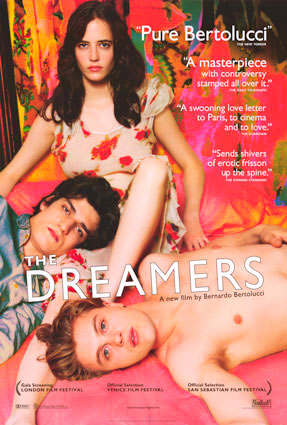
Why this image?*3 Dunno. It caught my eye.
And my eye isn't talking.
*1 It's like a computer boot up routine.
*2 I looked at a Peter Saul catalog recently, where a friend told me he said that he wants to foreground image over material. That stuck with me as I've wanted to do the opposite. That makes sense for his generation. I saw an early Peter Saul work on paper (1960), where you can see the generation that was working off the legacy of abstraction towards the PostModern figure. It makes sense to me that forty years later, an artist in my time would want to work in the opposite direction.
The Saul stuff looked frickin' great.
*3 Would Captain Willard be the type to let some eye candy movie poster catch his eye as he is sent up river into jungle Id to bust a cap on a rogue officer?
Don't think so.
January 10, 2004
Studio Visit

Just in time for the end of a week of woodshop, I had two visitors from Dallas into the studio. They are private dealers, homegrown here in Dallas. I googled them and found that they used to play with the heavy hitters when they did have a gallery some time ago. Richmond Burton, Ross Bleckner, Peter Halley, Jim Isermann... good company.
I was delighted to find that they were cool people. We had a great conversation and they invited Stephanie and I to go out to dinner this Sunday. I get to see their collection, lots of paintings. (Too bad Stephanie will have to go to New York -Brrrr cold, 10F degrees- that day, market week.)
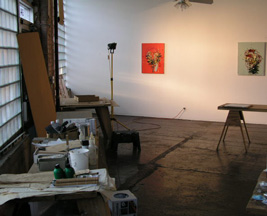
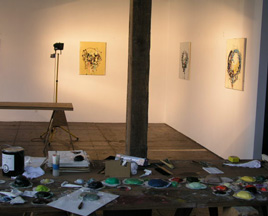
And they paid attention to the work. That doesn't happen all the time.
January 7, 2004
Speaking of the future...
Ahem...
I think I've just got a glimpse of the future.
When Juno passes away, I think we'll have her soul downloaded into this:
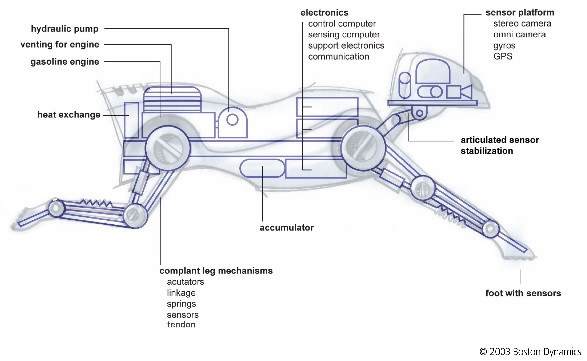
"Today's soldiers carry as much as 100 pounds of equipment. That's exhausting, even for the toughest grunt. In the future, the Army wants to dump up to half that gear onto the back of a drone. But military scientists are worried that robots with wheels won't be able to follow their human masters across mountain passes, up stairs and through forest trails.
To make their way across that kind of terrain, the drones will need legs -- maybe even four of them. So the Army's Tank-automotive and Armaments Command, orTACOM, has just doled out $2.25 million to two robotics firms to prototype a big, mechanical dog capable of carrying ammunition, food and supplies into battle."
(Remember the mars movie (Val Kilmer), that combat robot?)
Quantum-Quotidian
It?s always a scary thing when an artist discusses philosophy or physics, buuuut....
I read an article in the NYTimes recently that provoked a few thoughts:
The Time We Thought We Knew
By BRIAN GREENE
Published: January 1, 2004
?Relativity also upends the way we traditionally organize reality. Most of us imagine that reality consists of everything that exists right now ? everything that would be found, say, on a hypothetical freeze-frame image of the universe at this moment. The history of reality could thus be depicted by stacking one such freeze-frame image on top of the one that came before it, creating a cosmic version of an old-time flip-book. But this intuitive conception assumes a universal now, another stubborn remnant of Newton's absolutist thinking...
Today's scientists seeking to combine quantum mechanics with Einstein's theory of gravity (the general theory of relativity) are convinced that we are on the verge of another major upheaval, one that will pinpoint the more elemental concepts from which time and space emerge. Many believe this will involve a radically new formulation of natural law in which scientists will be compelled to trade the space-time matrix within which they have worked for centuries for a more basic "realm" that is itself devoid of time and space.This is such a perplexing idea that grasping it poses a substantial challenge, even for leading researchers. Broadly speaking, scientists envision that there will be no mention of time and space in the basic equations of the sought-for framework. And yet ? just as clear, liquid water emerges from particular combinations of an enormous number of H20 molecules ? time and space as we know them would emerge from particular combinations of some more basic, though still unidentified, entities. Time and space themselves, though, would be rendered secondary, derivative features, that emerge only in suitable conditions (in the aftermath of the Big Bang, for example). As outrageous as it sounds, to many researchers, including me, such a departure of time and space from the ultimate laws of the universe seems inevitable.
A hundred years ago today, the discovery of special relativity was still 18 months away, and science still embraced the Newtonian description of time. Now, however, modern physics' notion of time is clearly at odds with the one most of us have internalized. Einstein greeted the failure of science to confirm the familiar experience of time with "painful but inevitable resignation." The developments since his era have only widened the disparity between common experience and scientific knowledge. Most physicists cope with this disparity by compartmentalizing: there's time as understood scientifically, and then there's time as experienced intuitively. For decades, I've struggled to bring my experience closer to my understanding. In my everyday routines, I delight in what I know is the individual's power, however imperceptible, to affect time's passage. In my mind's eye, I often conjure a kaleidoscopic image of time in which, with every step, I further fracture Newton's pristine and uniform conception. And in moments of loss I've taken comfort from the knowledge that all events exist eternally in the expanse of space and time, with the partition into past, present and future being a useful but subjective organization.
***************************************
First of all, as for the article:
I love the future. I thrill to our optimism and lean into tomorrow. But sometimes I read articles like this and think of the George Jetson dreams that led Southern California to scrap the red car trains and build the freeways. Movies like ?Who framed Roger Rabbit?? got it wrong. Sure, there might well have been the Simon Legreedy types to have formed a conspiracy to accelerate consumerism and oil industry dominance. But it is true too, that the rail system was decrepit and over burdened by an exploding population (which it had ushered in the first place). The train was busted and LA didn't want to fix it. And it is true that we had swooned to dreams of the future that was innovation?s promise.
Here is Brian Greene, swooning, trying to bend the quotidian into the quantum. As hard it is to wrap our heads around the notions of a dissolving kaleidoscopic space/time... it?s tough to watch someone writhe, forcing an avant guarde idea where it might not fit. In other words, he?s trying too hard. He?s trying to apply the paradigm shift of the flat-to-round earth to Newtonian-to-Einstienian earthlings. Leave it alone! Maybe it?s ok to have each his own. Thinking out of the box is great, but wht is less than great is thinking like the last time we thought out of the box.
And what happened to both-and? Great circle curves are goemetric tools that you plot when you are a sailor crossing the ocean, but the line can still be straight when you are building a house. We live in a time when we are trying to build houses with great circle curves. Nutty. We, who like to swoon.
Surely, the most he can do is to imagine it in his everyday routines, and maybe this is where quantum mechanics has already made the inroad into modern life. Already, we enjoy magical realism, Kurt Vonnegut, Tarantino, and countless prime time tv shows traffic in this conceptual shift. On that level, the quantum is already quotidian. What else? I?m sure I could load several paragraphs of examples, but let?s move on....
******************************************
I was reading this and thinking about this exchange with a painter friend, ( which I?ll abbreviate as p.f., let me clear it with her first before I divulge her name):
D:The close ups are knock outs! The question is how to get that impact in the overall distant read. I think my work needs help in this regard, I think my stuff reads better close than far. The issue is to make them pop in both modes. The first thought I came to was to think about increasing the scale and volume of my instruments and paint. But I think there is for my work, an issue of the hand and the scale associated with it. It's like the anatomy of lizards versus dinosaurs. One might be able to walk on water and the other might have trouble getting blood to the brain.
p.f.:Since you were last in my studio, I've been re-thinking?the "far versus close" issue. I've come to the conclusion that I don't want to reconcile that duality. The issue for me is very much about looking (the quick, superficial glance)?vs. seeing (the conscious act of taking time?to discover). On one hand, I want my paintings to be indecipherable from a distance, the gaze sliding off the dense,?textile-like surface.
And then I read the Greene article.
If you click on the slide show in that NYTimes webpage, you?ll find this:
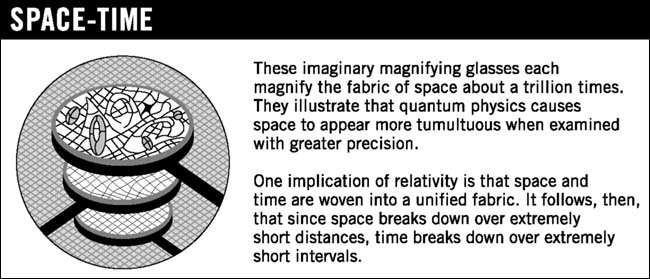
"...since space breaks down over extremely short intervals, time breaks down over extremely short intervals..."
So too space, even pictorial space. And I thought, maybe she?s right about this. Kinda funny, how I got all quantum-like in a quotidian look at painting.
**************************************************
I was thinking all quantum-like about our move to Spain. As one individual moves away from another, as in the thought experiment of the astronaut blasting from earth at high speed, the return trip would reveal that the astronaut had effectively traveled forward in time, the people he left behind would be much older, if even still alive at all. And here we were plotting our move abroad, forecasting when we might be able to return (I say anywhere from one to three... to nine years max. Why nine? A family secret, too much info for publication here. But definitely and eventually nine years max.) And when we return, all our pals will be older... and since I will avoid all mirrors, I will feel younger in my quantum arrogance.
A funny thought. ;-)
(an emoticon is needed to reassure jest)
Swirl
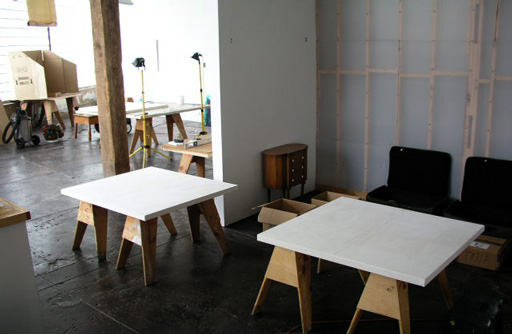
I've been building the last panels I'm likely to paint in CONUS for 2004. I'll be prepping works on paper too, so that'll do me for the next two months. I pretty much done with the panels, except for the sizing with mat resin, but that'll be fast. Today, I want to buy the material for- and build the crates. That way, I'm done with them once I finish painting.
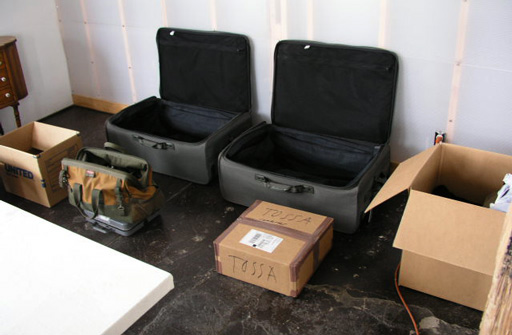
The preparations for departure are going on simultaneously. We've found a shipping service that seems good and priced right. As you can see, we are beginning a two month festival of packing. I imagine that we will be living out of suitcases for a month or more until we unpack in Tossa.
We've been wrangling the schedule pretty hard, getting family together to make a coordinated decision. Research into air fares is tinged with Al Queda poop. Should we take Lufthansa (muy caro!) or British Airways. What's with the air pilots' union and their antipathy towards air marshals? Stroking their moral vanity matters more than the safety of your passengers? I read that they think that their ground prep is superior enough to guarantee a highjack free flight. As it is said: "From their mouth to Gods ears." Only El-Al can make that claim.
Also, Juno's fate is a terribly touching issue. She has mast cell tumors, a form of cancer. It's not a communicable disease, one that is more like weeds: it will clutter up her system someday. Four months ago, the vet gave her six months to go. (We thought she was fitting right into our schedule! -gallows humor ;-)) She looks fine today. So it seems that we will take her with us to Spain, which is a small bit of trouble compared to the agony of leaving her behind in someone elses' care... or worse, putting her down prematurely, even if it is anitcipating the eventual by a month or two. Who knows, maybe she will live another year, maybe two... which would take her to the normal lifespan for a dog of her size and breed.
January 3, 2004
Tapped on the Shoulder
A few nights ago, we noticed this noise in the living room. I would get up and check it out. Was there someone at the door? Tap tap tap. Just as I would emerge from the bedroom, the noise would end. This happened several times. Tap tap tap. Out of bed in my pajamas, I pad barefoot looking for around for the source of the noise. Nothing. Back to bed. Tap tap tap. Repeat. Was there someone messing with us outside?
There's a homeless shelter a block and a half away from us where they serve free dinners to the unfortunate indigents. So there would be no surprise if some guy was knocking his gear against the glass block that forms the outer walls of our place. I imagined some dude looking like a scary Jesus, knocking a tin against the wall to get that last Vienna Sausage. So I put my boots on and I grab my trusty studio jacket and I take Juno outside to go pee. The homeless give me wide berth when I'm out with my 85 lb black French Shepard. She looks like the devil, but they don't know she's a pussy willow.
Nope. No dude was making the noise. But I did notice something new. Our landlords affixed a "for lease" sign out on the corner of the building. That's cool. The bungie chords would whip against the glass block windows as the wind would act up. That must be it.
So over the days, we got used to the new sound. Tap tap tap. Sometimes weak, sometimes hard. Tap tap tap. Tap tap tap. (A whisper: taptaptap.) Tap tap tap.
Tonight, as we were in bed, the topic of the upcoming move to Spain surfaces, now with a regularity. Two months to start the move, one month to make it. What do we do first, second and third? What's the calendar going to look like? What do we take with us? What do we leave behind?
Tap tap tap. The wind is kicking up tonight. Tap tap tap. And then it hit me: this sound is like a finger tapping us on the shoulder. "Hey, you're going to move soon. Hey, you've got a lot to do. Hey, you've got eight weeks to go."
Stephanie recalled that this reminds her of Poe:Presently my soul grew stronger; hesitating then no longer,
"Sir," said I, "or Madam, truly your forgiveness I implore;
But the fact is I was napping, and so gently you came rapping,
And so faintly you came tapping, tapping at my chamber door,
That I scarce was sure I heard you"--here I opened wide the door--
Darkness there and nothing more.
January 2, 2004
PaperWork
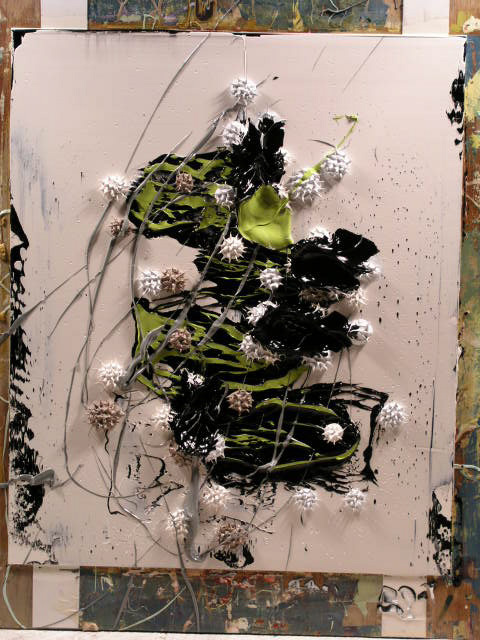
I'm not really sure how to write about these works on paper shown here.
I'm caught as usual in the matrix of materiality, representation, a desire to convulse the paint into new territory, an effort to think in and through painting, and to stack clarity and clash of different mark making at an acute condition.
It's like the kids game of "Cat's Cradle" where the painting is the string strung in different ways between the surrounding poles of fingers.
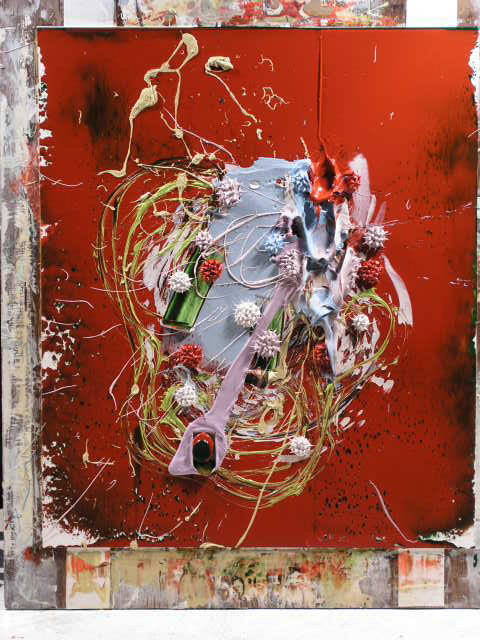
I'm agitated.
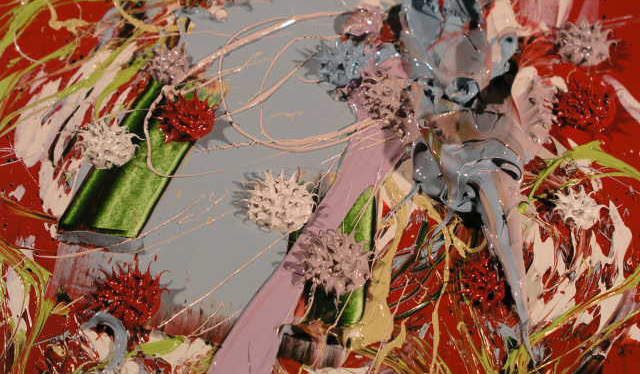
My expectations are frustrated.
That's not always bad.
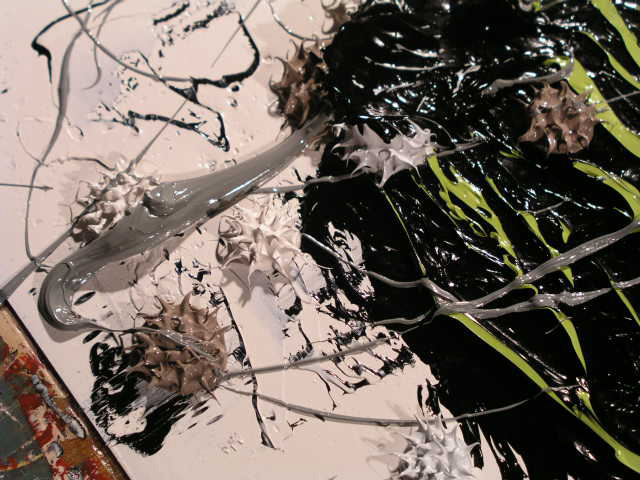
Usually, it's like this: I set out to try something, sometime it works, sometimes it doesn't.
When it doesn't, I throw a wrench into the works. When it does, i throw a wrench into the works.
Then I try to make it work.
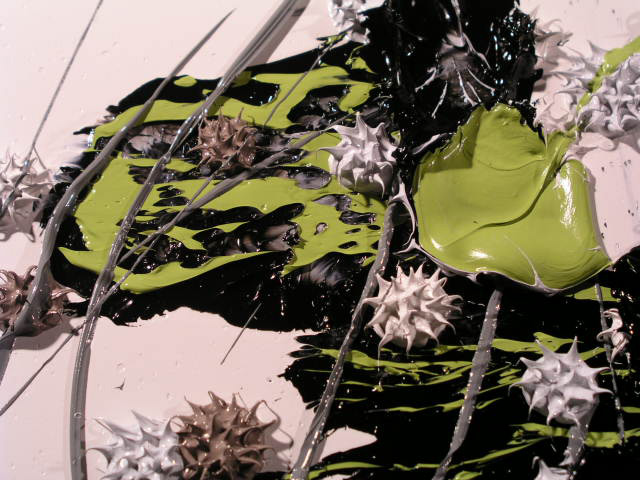
Then I stop.
Gaposis
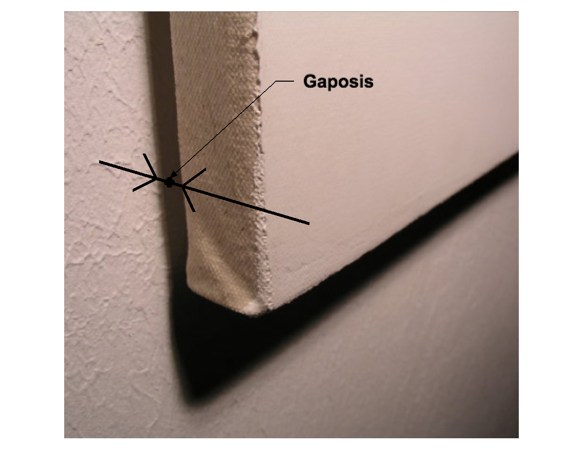
As for the panel trouble, here's the thing: there's always a little variation and imperfection in the construction of the panels I paint on, that's natural. But the last panel of the series I have been working on lately is eccentric to the cusp. Simply speaking, the surface is warped like a potato chip. It's real subtle, but it is twice as much as the worst variation in the other panels. I could have shrugged my shoulders, painted on it and shipped it off, but I know it is a defect. Sometimes, most times the galleries will notice the defect, especially as the lighting can show a tell tale deformed shadow. I could have glued a piece of velcro to tack it back to the wall. But that would underscore the problem. So I decided to trash the panel. At least, by doing this I can avoid undesireable attention to the small variation in the other panels. I won't have my six that I planned, but five is a good number too. There's something nice about an odd number, being not as static as an even one.
This took four days.
Studio 2004
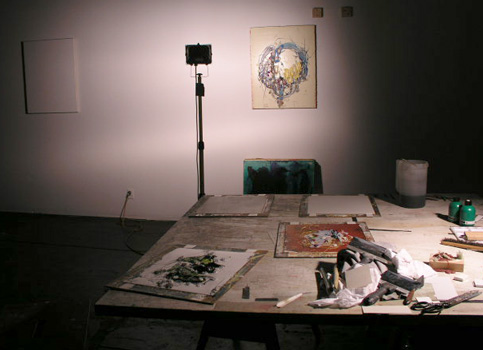
Yea, it's been a few days since the last post. For reasons yet unexamined, I've held off posting... maybe it was a bit of indecision as to how to proceed... maybe it was some trouble with the last panel of the recent series I've been painting... maybe it was the holidays, maybe it was that I don't know how to write about what I'm doing, what I'm thinking...maybe, maybe...
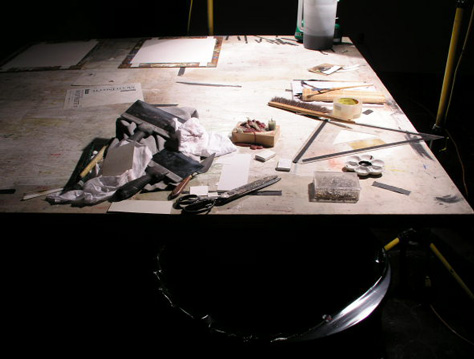
Well, happy new year everyone. So much of what's coming will be so new for us. Stephanie and I have been talking of the logistics of moving to Spain. It kind of makes our heads spin. Do we stash our stuff in California or Texas? Should we keep our household stuff at all? Should we dispose of things like T.V's and the like which will be antiquated by the time we return? (Sometimes this feels likes a time machine!) Should we try to ship it all to Spain? (A little googling helped us find moving companies like MAERSK SeaLand Containers.) How long can we expect to stay in Spain before we can return to the states? How much can we reasonable anticipate right now?

Meanwhile, we have been to a couple of parties here in Dallas. In the first of the week, we enjoyed a get together held at our landlords (Pamela and Bill Nelson) place. Lots of people, we met many local artists and raconteurs. Tamales, a gift exchange and warm conversations all around. We also had a chance to catch up with our neighbors here in the depths of downtown Dallas, cool people wrangling interesting buildings as home and businesses.
Today, we went to a party at Dee Mitchell's house in a leafy residential neighborhood nearby. A beautiful house and a great collection of art and books. Dee is a writer for Art in America and the Dallas Morning News. A really nice guy with a great dispostion. We hung out with a growing circle of acquaintences who are morphing into friends. We are meeting alot of good people here, and our exit can begin to feel a bit rueful as our affection grows for them. I'm beginning to notice the same people at all these art events, and I note the warm feeling between them that sets them apart from other art scenes.
I wish I had brought my camera to shoot some snaps for you, but I feel like a geek that way. Sorry, but I'm socially awkward as it is.